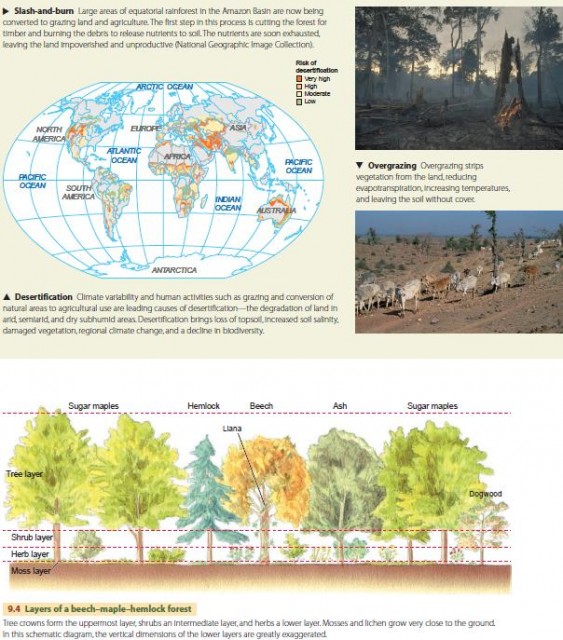Natural Vegetation
Over the last few thousand years, human societies have come to dominate much of the land area of our planet. We've changed the natural vegetation—sometimes drastically—of many regions. What exactly do we mean by natural vegetation? Natural vegetation is a plant cover that develops with little or no human interference. It is subject to natural forces, storms, or fires that can modify or even destroy it. Natural vegetation can still be seen over vast areas of the wet equatorial climate , although the rainforests there are being slowly cleared. Much of the arctic tundra and the boreal forest of the subarctic zones is in a natural state.
In contrast, there is also human-influenced vegetation. Much of the midlatitude land surface is totally under human control, through intensive agriculture, grazing, or urbanization. Other areas appear to be untouched but may actually be dominated by human activity in a subtle manner. For example, most national parks and national forests have been protected from fire for many decades. As a result, dead branches and debris have accumulated on the forest floor, creating fuel loads that encourage hot, damaging, crown fires rather than cooler, sparser, understory fires that leave the larger, healthier, trees alive.
Humans have also moved plant species from their original habitats to foreign lands and foreign environments. Sometimes exported plants thrive like weeds, forcing out natural species and becoming a major nuisance. Other human activities such as clear-cutting, slash-and-burn agriculture, overgrazing, and woodgathering have had profound effects on the plant species and the productivity of the land.
STRUCTURE AND LIFE-FORM OF PLANTS
Plants come in many types, shapes, and sizes. Botanists recognize and classify plants by species. However, the biogeographer is less concerned with individual species and more interested in plant cover as a whole. So, when talking about plant cover, plant geographers discuss the life-form of the plant—its physical structure, size, and shape. Most life-form names are in common use, and you're probably familiar with them already, but we'll quickly review them now.
Figure 9.4 illustrates various plant life-forms. Trees and shrubs are erect, woody plants. They are perennial, meaning that their woody tissues endure from year to year. Most have life spans of many years. Trees are large plants with a single upright main trunk, often with few branches in the lower part but branching in the upper part to form a crown. Shrubs have several stems branching from a base near the soil surface, creating a mass of foliage close to ground level.

Lianas are also woody plants, but they take the form of vines supported on trees and shrubs. Lianas include tall, heavy vines in the wet equatorial and tropical rainforests and also some woody vines of midlatitude forests. English ivy, poison ivy or oak, and Virginia creeper are familiar North American examples of lianas.
Herbs make up a major class of plant life-forms. They lack woody stems and so are usually small, tender plants. They occur in a wide range of shapes and leaf types. Some are annuals, living only for a single season. Some herbs are broad-leaved, and others are narrow-leaved, such as grasses. Herbs share few characteristics with each other, except that they usually form a lower layer than shrubs and trees. Lichens also grow close to the ground (Figure 9.5). They are life-forms in which algae and fungi live together, forming a single plant structure. Lichens dominate the vegetation in some alpine and arctic environments.

Forest is a vegetation structure in which trees grow close together. The crowns of forest trees often touch, so that their foliage largely shades the ground. Many forests in moist climates show at least three layers of life-forms—the tree, shrub, and herb layers. There is sometimes a fourth, lowermost layer of mosses and related very small plants. In woodland, tree crowns are separated by open areas that usually have a low herb or shrub layer.